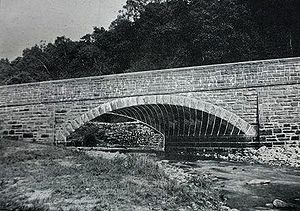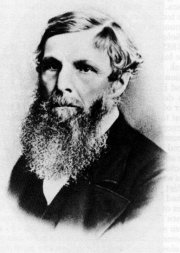
An arch bridge is a bridge with abutments at each end shaped as a curved arch. Arch bridges work by transferring the weight of the bridge and its loads partially into a horizontal thrust restrained by the abutments at either side, and partially into a vertical load on the arch supports. A viaduct may be made from a series of arches, although other more economical structures are typically used today.

Gatehampton Railway Bridge, otherwise referred to as Gatehampton Viaduct, is a railway bridge carrying the Great Western Main Line over the River Thames in Lower Basildon, Berkshire, England. It takes the line between the stations at Goring and Streatley and Pangbourne, and crosses the Thames on the reach between Whitchurch Lock and Goring Lock.

The Seventh Street Improvement Arches are a double-arched masonry highway bridge that formerly spanned the St. Paul and Duluth Railroad tracks in Saint Paul, Minnesota, United States. The Seventh Street Improvement Arches are historically significant for its rarity and the technically demanding nature of its skewed, helicoidal spiral, stone-arch design. The bridge is one of the few of its type in the United States, and is the only known bridge of its type in Minnesota. It was built from 1883 to 1884 by Michael O'Brien and McArthur Brothers of Chicago and was designed by William A. Truesdell. The bridge was listed on the National Register of Historic Places in 1989 and on the American Society of Civil Engineers Historic Civil Engineering Landmarks in 2000.

The Store Street Aqueduct in central Manchester, England, was built in 1798 by Benjamin Outram on the Ashton Canal. A Grade II* listed building, it is built on a skew of 40° across Store Street, and is believed to be the first major aqueduct of its kind in Great Britain and the oldest still in use today.
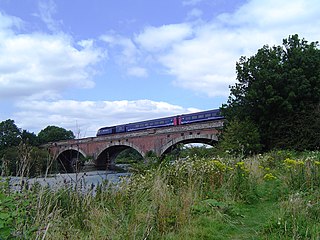
Moulsford Railway Bridge, also known locally as "Four Arches" bridge, is a pair of parallel bridges located a little to the north of Moulsford and South Stoke in Oxfordshire, UK. It carries the Great Western Main Line from Paddington, London to Wales and the West across the River Thames. The bridge lies between the stations at Goring & Streatley and Cholsey, and crosses the Thames at an oblique angle on the reach between Cleeve Lock and Benson Lock.
George Watson Buck (1789–1854) was the engineer of the Montgomeryshire Canal in the early 19th century, and was responsible for the unique lock paddle design.
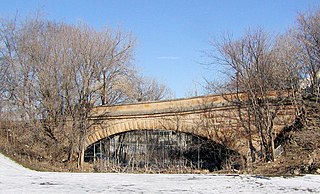
The Colorado Street Bridge also known as Bridge L-8803 is a masonry and brick arch bridge in Saint Paul, Minnesota's West Side neighborhood. It is 58 feet (18 m) wide and consists of a single oblique span of 70 feet 6 inches (21.49 m) that was built with the arch courses running parallel to the abutments, leading to a weaker structure than other skew arch construction methods, known as a false skew arch. It was designed in 1888 by Andreas W. Munster of the Saint Paul Engineer's Office and is now restricted to pedestrian traffic.

Victoria Viaduct, originally known as the Victoria Bridge, is a stone arch rail viaduct spanning the River Wear about 1 mile (1.6 km) south-east of Washington in the City of Sunderland North East England. It was built as part of the Durham Junction Railway under the supervision of Thomas Elliot Harrison.

Southdown Road Skew Bridge is a ribbed skew arch railway bridge, which carries the Midland Main Line across Southdown Road in Harpenden, Hertfordshire. Built of brick by the Midland Railway and opening in 1868, it is notable for its extreme skew angle of approximately 65°.

Neidpath Viaduct, occasionally known as the Queen's Bridge, consists of eight stone skew arches and was built to carry the Symington to Peebles branch line of the Caledonian Railway over the River Tweed to the south-west of Neidpath Castle. Now closed to rail traffic the bridge is used as a footpath.

Lyne Viaduct is a viaduct at Lyne in the Scottish Borders of Scotland. It consists of three stone skew arches and a plate girder approach span over a minor road and was built to carry the Symington to Peebles branch line of the Caledonian Railway over Lyne Water to the west of Peebles. Now closed to rail traffic the bridge is used as a footpath.
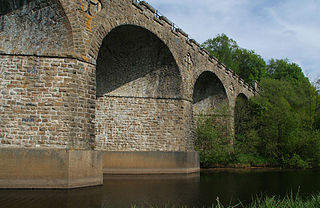
Kielder Viaduct consists of seven semi-circular masonry skew arches and was built in 1862 by the North British Railway to carry the Border Counties Line across marshy land, which following flooding to create Kielder Water, became the place where Deadwater Burn joins Bakethin Reservoir. Now closed to rail traffic, the bridge is currently used as a footpath.

Peter Nicholson was a Scottish architect, mathematician and engineer. Largely self-taught, he was apprenticed to a cabinet-maker but soon abandoned his trade in favour of teaching and writing. He practised as an architect but is best remembered for his theoretical work on the skew arch, his invention of draughtsman's instruments, including a centrolinead and a cyclograph, and his prolific writing on numerous practical subjects.

Hereford Road Skew Bridge is a disused railway bridge in Ledbury, Herefordshire. Built in 1881 to carry the Ledbury and Gloucester Railway across the Hereford Road at an angle of approximately 45°, it was built as a ribbed skew arch with stone spandrels and wing walls, and ribs of blue brick. The railway line was closed in 1959 and the bridge is now used as part of the Ledbury Town Trail footpath.
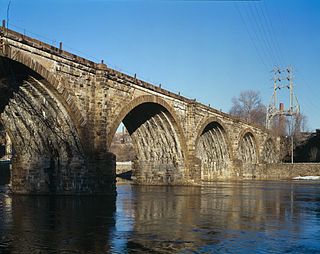
The Philadelphia and Reading Railroad, Schuylkill River Viaduct, also called the Reading Railroad Bridge and the Falls Rail Bridge, is a stone arch bridge that carries rail traffic over the Schuylkill River at Falls of Schuylkill in Philadelphia, Pennsylvania. Located in Fairmount Park, the bridge also spans Martin Luther King, Jr., Drive, and Kelly Drive. The name Philadelphia & Reading Railroad (P&R) was later shortened to Reading Company.

William Chapman (1749–1832) was an English engineer. Born in Whitby, he worked on the construction of the Old and Humber Docks in Hull, as well as many drainage and canal projects. He is credited with the invention of the bogie and articulation for rail vehicles.

The River Irwell Railway Bridge was built for the Liverpool & Manchester Railway (L&MR), the world's first passenger railway which used only steam locomotives and operated as a scheduled service, near Water Street in Manchester, England. The stone railway bridge, built in 1830 by George Stephenson, was part of Liverpool Road railway station. The bridge was designated a Grade I listed building on 19 June 1988.

Swin Bridge is the local name for a skew arch bridge in County Durham. It was built in 1830 for the Haggerleases branch of the Stockton and Darlington Railway, crossing the River Gaunless at Cockfield. It is important as an early example of the masonry arch skew bridge, and the first used to carry a railway.

The Gelt Bridge or Gelt Viaduct is a skew arch railway viaduct in the parish of Hayton, east of Carlisle in Cumbria, north west England. Built from 1832, it is one of the earliest and largest skew bridges in Britain. It is a Grade II* listed building.

Abbots Langley railway bridge, also known as the bridge over Railway Terrace is a skew bridge carrying the West Coast Main Line over a road near Abbots Langley, Hertfordshire, in Eastern England. The angle of the bridge creates a 25-metre (82-foot) tunnel along the road. It was built in 1837 and is a Grade II listed building.
